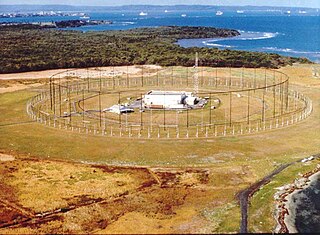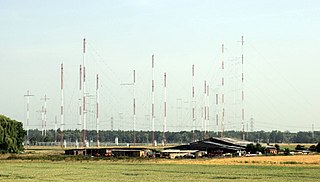
Signals intelligence (SIGINT) is the act and field of intelligence-gathering by interception of signals, whether communications between people or from electronic signals not directly used in communication. Signals intelligence is a subset of intelligence collection management. As classified and sensitive information is usually encrypted, signals intelligence may necessarily involve cryptanalysis. Traffic analysis—the study of who is signaling to whom and in what quantity—is also used to integrate information, and it may complement cryptanalysis.

Royal Air Force Chicksands or more simply RAF Chicksands, was a Royal Air Force station located 7.7 miles south east of Bedford, Bedfordshire and 11.6 miles north east of Luton, Bedfordshire. It closed in 1997 when responsibility for the camp was taken over by the British Army Intelligence Corps. Near the town of Shefford it is named after Chicksands Priory, a 12th-century Gilbertine monastery located within the perimeter of the camp.

Direction finding (DF), or radio direction finding (RDF), is the use of radio waves to determine the direction to a radio source. The source may be a cooperating radio transmitter or may be an inadvertant source, a naturally-occurring radio source, or an illicit or enemy system. Radio direction finding differs from radar in that only the direction is determined by any one receiver; a radar system usually also gives a distance to the object of interest, as well as direction. By triangulation, the location of a radio source can be determined by measuring its direction from two or more locations. Radio direction finding is used in radio navigation for ships and aircraft, to locate emergency transmitters for search and rescue, for tracking wildlife, and to locate illegal or interfering transmitters. During the Second World War, radio direction finding was used by both sides to locate and direct aircraft, surface ships, and submarines.

High-frequency direction finding, usually known by its abbreviation HF/DF or nickname huff-duff, is a type of radio direction finder (RDF) introduced in World War II. High frequency (HF) refers to a radio band that can effectively communicate over long distances; for example, between U-boats and their land-based headquarters. HF/DF was primarily used to catch enemy radios while they transmitted, although it was also used to locate friendly aircraft as a navigation aid. The basic technique remains in use as one of the fundamental disciplines of signals intelligence, although typically incorporated into a larger suite of radio systems and radars instead of being a stand-alone system.

A circularly disposed antenna array (CDAA), sometimes referred to as a circularly disposed dipole array (CDDA) or a wullenweber, is a large circular antenna array used for radio direction finding. They are used by military and government agencies to triangulate radio signals for radio navigation, intelligence gathering, search and rescue, and enforcement of broadcasting laws. Because their huge circular reflecting screens looks like circular fences, some antennas have been colloquially referred to as "elephant cages". The term "wullenwever" was the World War II German cover term used to identify their secret CDAA research and development program; its name is unrelated to any person involved in the program.

Canadian Forces Station Leitrim, also referred to as CFS Leitrim, is a Canadian Forces Station located in the neighbourhood of Leitrim in Ottawa, Ontario. It is concerned with the interception, decrypting and processing of communication for the Communications Security Establishment and the Canadian Forces, and forms part of the ECHELON system.

Galeta Island is an island located on the Atlantic side of the Republic of Panama, just east of the city of Colón, Panama.
San Vito dei Normanni Air Station was a United States Air Force facility located 7 miles (11 km) west of Brindisi, Apulia, between the port of Brindisi and the town of San Vito dei Normanni, Italy.

Silver Strand Training Complex South (SSTC-S), formerly known as the Naval Radio Receiving Facility (NRRF), is the premier training facility for U.S. Special Operations Forces. Located between Imperial Beach and Silver Strand State Beach near San Diego in southern California, USA, this facility was known by locals as the "elephant cage" which is a nickname for the large Wullenweber direction finder antenna. The antenna was used to provide direction finding, primary communication links for U.S. Navy submarines. The antenna was finally dismantled in 2015, even though it was scheduled to be removed in fiscal year 2007. Presently the area is part of Naval Base Coronado and commanded by that base's Commanding Officer. While just north of Imperial Beach, it is within the city limits of Coronado.

Naval Security Group Activity, Winter Harbor was a radio station of the United States Navy that operated from 1935 to 2002.

Wacław Struszyński was a Polish electronics engineer who made a vital contribution to the defeat of U-boats in the Battle of the Atlantic. He designed an exceptional radio antenna which enabled effective high frequency (HF) radio direction finding systems to be installed on Royal Navy convoy escort ships. Such direction finding systems were referred to as HF/DF or Huff-Duff, and enabled the bearings of U-boats to be determined when the U-boats made high frequency radio transmissions.
Gablingen Kaserne is a former military facility in Gablingen near Augsburg, Germany, which was closed in 1998. Its primary use was signals intelligence collection during the Cold War.
Skaggs Island Naval Communication Station is a former United States Navy installation located near California State Route 37 between Novato and Vallejo, California. It was a secretive, secure, and self-contained naval base, engaged in a number of communications and intelligence gathering functions for the Navy and other federal intelligence organizations. The 3,310-acre (13.4 km2) site was purchased by the Navy in 1941, and closed in 1993. The antennas continued to be used for some time after that, but by 2013 they were removed along with all of the remaining buildings.

Initially established as the Air Force (USAF) Security Group in June, 1948, the USAF Security Service (USAFSS) was activated as a major command on 20 October 1948.

The AN/FLR-9 is a type of very large circularly disposed antenna array, built at eight locations during the cold war for HF/DF direction finding of high priority targets. The worldwide network, known collectively as "Iron Horse", could locate HF communications almost anywhere on Earth. Because of the exceptionally large size of its outer reflecting screen, the FLR-9 was commonly referred to by the nickname "Elephant Cage." Constructed in the early to mid 1960s, in May 2016 the last operational FLR-9 at Joint Base Elmendorf-Richardson in Alaska was decommissioned. It can be confused with the US Navy's AN/FRD-10, which also used a circularly disposed antenna array.

Canadian Forces Station Masset was a Canadian Forces station and signals intercept facility located near Masset, British Columbia. The station was officially stood-down on 1 April 1997 and re-established as Canadian Forces Station Leitrim Detachment Masset.

Curtain arrays are a class of large multielement directional radio transmitting wire antennas, used in the shortwave radio bands. They are a type of reflective array antenna, consisting of multiple wire dipole antennas, suspended in a vertical plane, often in front of a "curtain" reflector made of a flat vertical screen of many long parallel wires. These are suspended by support wires strung between pairs of tall steel towers, up to 90 m high. They are used for long-distance skywave transmission; they transmit a beam of radio waves at a shallow angle into the sky just above the horizon, which is reflected by the ionosphere back to Earth beyond the horizon. Curtain antennas are mostly used by international short wave radio stations to broadcast to large areas at transcontinental distances.
Maxwell K. Goldstein was a first generation Jewish-American scientist and engineer who was instrumental in the development and deployment of high-frequency direction finding by the United States Navy during the Second World War. High-frequency direction finding played a significant role in the Allies efforts to counter the threat of German U-boats (submarines) during the Battle of the Atlantic. This success helped ensure the continued flow of equipment and supplies from the United States to Britain and to European battlefields, which was a critical factor in the ultimate Allied victory. Following World War II, Goldstein founded Balco Research Laboratory, which specialized in high resistance capacitors used in numerous military, civilian, and NASA projects.

Naval Computer and Telecommunications Station Guam is a United States Navy communications facility on the U.S. territory of Guam. It is located on the Naval Base Guam North Finegayan Telecommunications Site along Guam Highway 3 in Dededo, on the northwest coast of the island.
Project Boresight was a United States program that built radio-location systems to find the position of Russian submarines that were using burst communications. It was created as a top-secret program.























